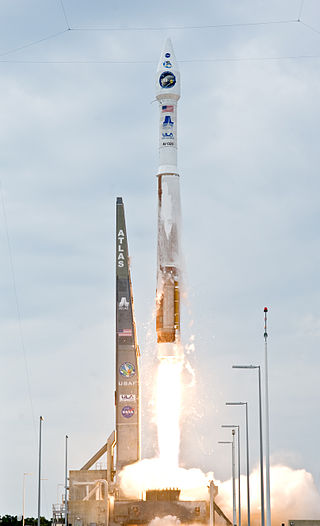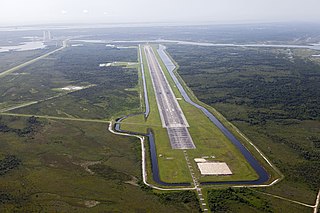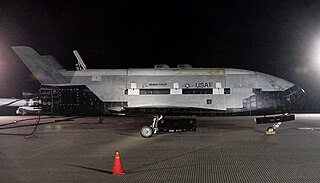
Cape Canaveral Space Force Station (CCSFS) is an installation of the United States Space Force's Space Launch Delta 45, located on Cape Canaveral in Brevard County, Florida.

A spaceplane is a vehicle that can fly and glide like an aircraft in Earth's atmosphere and maneuver like a spacecraft in outer space. To do so, spaceplanes must incorporate features of both aircraft and spacecraft. Orbital spaceplanes tend to be more similar to conventional spacecraft, while sub-orbital spaceplanes tend to be more similar to fixed-wing aircraft. All spaceplanes to date have been rocket-powered for takeoff and climb, but have then landed as unpowered gliders.

The Boeing X-37, also known as the Orbital Test Vehicle (OTV), is a reusable robotic spacecraft. It is boosted into space by a launch vehicle, then re-enters Earth's atmosphere and lands as a spaceplane. The X-37 is operated by the Department of the Air Force Rapid Capabilities Office, in collaboration with United States Space Force, for orbital spaceflight missions intended to demonstrate reusable space technologies. It is a 120-percent-scaled derivative of the earlier Boeing X-40. The X-37 began as a NASA project in 1999, before being transferred to the United States Department of Defense in 2004. Until 2019, the program was managed by Air Force Space Command.

Atlas V is an expendable launch system and the fifth major version in the Atlas launch vehicle family. It was originally designed by Lockheed Martin, now being operated by United Launch Alliance (ULA), a joint venture between Lockheed Martin and Boeing. It is used for DoD, NASA, and Commercial payloads. It is America's longest-serving active rocket. After 87 launches, in August 2021 ULA announced that Atlas V would be retired, and all 29 remaining launches had been sold. As of 6 October 2023, 17 launches remain.
Space Shuttle missions designated STS-3xx were rescue missions which would have been mounted to rescue the crew of a Space Shuttle if their vehicle was damaged and deemed unable to make a successful reentry. Such a mission would have been flown if Mission Control determined that the heat shielding tiles and reinforced carbon-carbon panels of a currently flying orbiter were damaged beyond the repair capabilities of the available on-orbit repair methods. These missions were also referred to as Launch on Demand (LOD) and Contingency Shuttle Crew Support. The program was initiated following loss of Space Shuttle Columbia in 2003. No mission of this type was launched during the Space Shuttle program.

FalconSAT is the United States Air Force Academy's (USAFA) small satellite engineering program. Satellites are designed, built, tested, and operated by Academy cadets. The project is administered by the USAFA Space Systems Research Center under the direction of the Department of Astronautics. Most of the cadets who work on the project are pursuing a bachelor of science degree in astronautical engineering, although students from other disciplines join the project.

The Shuttle Landing Facility (SLF), also known as Launch and Landing Facility (LLF), is an airport located on Merritt Island in Brevard County, Florida, United States. It is a part of the Kennedy Space Center and was used by Space Shuttle for landing until July 2011. It was also used for takeoffs and landings for NASA training jets such as the Shuttle Carrier Aircraft and for civilian aircraft.
The Space Test Program (STP) is the primary provider of spaceflight for the United States Department of Defense (DoD) space science and technology community. STP is managed by a group within the Advanced Systems and Development Directorate, a directorate of the Space and Missile Systems Center of the United States Space Force. STP provides spaceflight via the International Space Station (ISS), piggybacks, secondary payloads and dedicated launch services.

USA-212 was the first flight of the Boeing X-37B Orbital Test Vehicle 1, an American robotic vertical-takeoff, horizontal-landing (VTHL) spaceplane. It was launched aboard an Atlas V rocket from Cape Canaveral on 22 April 2010, and operated in low Earth orbit. Its designation is part of the USA series.

USA-226 was the first flight of the second Boeing X-37B, the Orbital Test Vehicle 2, an American unmanned robotic vertical-takeoff, horizontal-landing spaceplane. It was launched aboard an Atlas V rocket from Cape Canaveral on 5 March 2011, and landed at Vandenberg Air Force Base on 16 June 2012. It operated in low Earth orbit. Its mission designation is part of the USA series.

In 2015, the maiden spaceflights of the Chinese Long March 6 and Long March 11 launch vehicles took place.

USA-240, also referred to as Orbital Test Vehicle 3 (OTV-3), is the second flight of the first Boeing X-37B, an American unmanned robotic vertical-takeoff, horizontal-landing spaceplane. It was launched to low Earth orbit aboard an Atlas V rocket from Cape Canaveral on 11 December 2012. Its mission designation is part of the USA series.

The Space Rider is a planned uncrewed orbital lifting body spaceplane aiming to provide the European Space Agency (ESA) with affordable and routine access to space. Contracts for construction of the vehicle and ground infrastructure were signed in December 2020. Its maiden flight is currently scheduled for the third quarter of 2025.

USA-261, also referred to as Orbital Test Vehicle 4 (OTV-4) or AFSPC-5, is the second flight of the second Boeing X-37B, an American unmanned vertical-takeoff, horizontal-landing spaceplane. It was launched to low Earth orbit aboard an Atlas V rocket from Cape Canaveral on May 20, 2015. Its mission designation is part of the USA series.
The Chinese reusable experimental spacecraft is the first reusable spacecraft produced by China. It embarked upon its initial orbital mission on 4 September 2020. According to media reports, the CSSHQ is launched into Earth orbit in a vertical configuration while enclosed within the payload fairings of a rocket like a traditional satellite or space capsule, but it returns to Earth via a runway landing like a conventional aircraft; the landing is conducted autonomously. In the absence of any official descriptions of the spacecraft or photographic depictions thereof, some observers have speculated that the CSSHQ may resemble the X-37B spaceplane of the United States in both form and function.

USA-299, also referred to as USSF-7 and Orbital Test Vehicle 6 (OTV-6), is the third flight of the first Boeing X-37B, an American unmanned vertical-takeoff, horizontal-landing spaceplane. It was launched to low Earth orbit aboard an Atlas V launch vehicle from SLC-41 on 17 May 2020. Its mission designation is part of the USA series.

USA-292, also known as Advanced Extremely High Frequency 5 or AEHF-5, is a military communications satellite operated by the United States Space Force. It is the fifth of six satellites to be launched as part of the Advanced Extremely High Frequency program, which replaced the earlier Milstar system.

USA-298, also known as Advanced Extremely High Frequency 6 or AEHF-6, is a military communications satellite operated by the United States Space Force (USSF). It is the sixth of six satellite to be launched as part of the Advanced Extremely High Frequency program, which replaced the earlier Milstar system.

United States Space Force-52 (USSF-52), also referred to as Orbital Test Vehicle 7 (OTV-7), will be the fourth flight of the second Boeing X-37B, an American unmanned vertical-takeoff, horizontal-landing spaceplane. It will be launched to low Earth orbit aboard a Falcon Heavy rocket from LC-39A December 2023.















